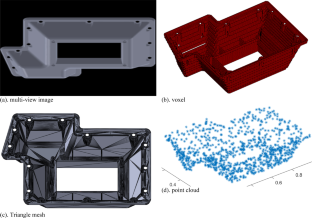Journal of Intelligent Manufacturing ( IF 8.3 ) Pub Date : 2024-04-16 , DOI: 10.1007/s10845-024-02368-5 Zhichao Wang , Xiaoliang Yan , Jacob Bjorni , Mahmoud Dinar , Shreyes Melkote , David Rosen

|
Given a part design, the task of manufacturing process selection chooses an appropriate manufacturing process to fabricate it. Prior research has traditionally determined manufacturing processes through direct classification. However, an alternative approach to select a manufacturing process for a new design involves identifying previously produced parts with comparable shapes and materials and learning from them. Finding similar designs from a large dataset of previously manufactured parts is a challenging problem. To solve this problem, researchers have proposed different spatial and spectral shape descriptors to extract shape features including the D2 distribution, spherical harmonics (SH), and the Fast Fourier Transform (FFT), as well as the application of different machine learning methods on various representations of 3D part models like multi-view images, voxel, triangle mesh, and point cloud. However, there has not been a comprehensive analysis of these different shape descriptors, especially for part similarity search aimed at manufacturing process selection. To remedy this gap, this paper presents an in-depth comparative study of these shape descriptors for part similarity search. While we acknowledge the importance of factors like part size, tolerance, and cost in manufacturing process selection, this paper focuses on part shape and material properties only. Our findings show that SH performs the best among non-machine learning methods for manufacturing process selection, yielding 97.96% testing accuracy using the proposed quantitative evaluation metric. For machine learning methods, deep learning on multi-view image representations is best, yielding 99.85% testing accuracy when rotational invariance is not a primary concern. Deep learning on point cloud representations excels, yielding 99.44% testing accuracy when considering rotational invariance.
中文翻译:

基于相似性搜索的制造工艺选择:在形状描述符比较中纳入非形状信息
给定零件设计,制造工艺选择的任务是选择合适的制造工艺来制造它。先前的研究传统上通过直接分类来确定制造工艺。然而,为新设计选择制造工艺的另一种方法是识别以前生产的具有可比形状和材料的零件,并从中学习。从先前制造的零件的大型数据集中找到类似的设计是一个具有挑战性的问题。为了解决这个问题,研究人员提出了不同的空间和光谱形状描述符来提取形状特征,包括D2分布、球谐函数(SH)和快速傅里叶变换(FFT),以及不同的机器学习方法在各种形状特征上的应用。 3D 零件模型的表示,例如多视图图像、体素、三角形网格和点云。然而,还没有对这些不同的形状描述符进行全面的分析,特别是针对制造工艺选择的零件相似性搜索。为了弥补这一差距,本文对这些用于零件相似性搜索的形状描述符进行了深入的比较研究。虽然我们承认零件尺寸、公差和成本等因素在制造工艺选择中的重要性,但本文仅关注零件形状和材料特性。我们的研究结果表明,SH 在用于制造工艺选择的非机器学习方法中表现最好,使用所提出的定量评估指标产生 97.96% 的测试精度。对于机器学习方法,多视图图像表示的深度学习是最好的,当旋转不变性不是主要问题时,可以产生 99.85% 的测试精度。点云表示的深度学习表现出色,在考虑旋转不变性时,测试准确率高达 99.44%。



























 京公网安备 11010802027423号
京公网安备 11010802027423号